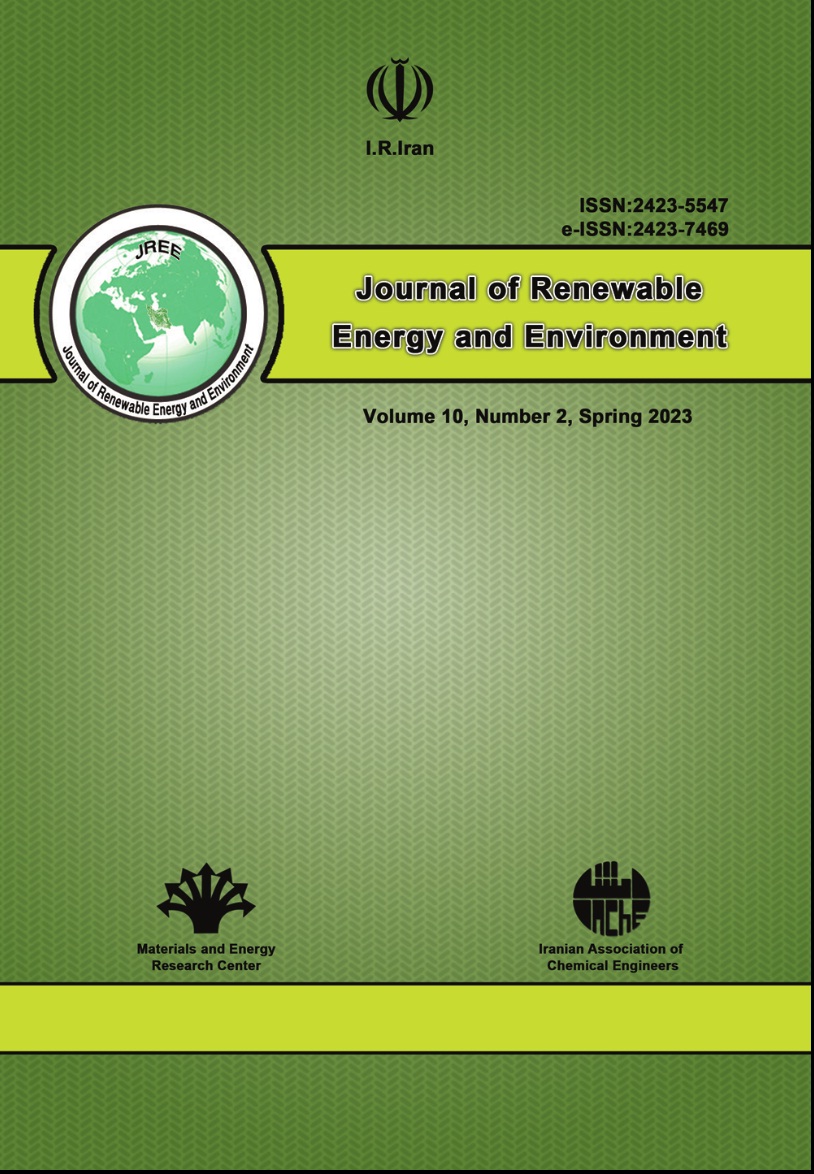Document Type : Research Article
Authors
Renewable and Sustainable Energy Laboratory, Department of Mechanical Engineering, School of Engineering, Kathmandu University, P. O. Box: 6250, Dhulikhel, Nepal.
Abstract
Anaerobic digestion is one of the most effective technologies for managing degradable waste, which produces renewable energy and digestate as the byproduct. In this study, sewage sludge (SS), poultry litter (PL), and food waste (FW) were co-digested at ratios (SS:PL:FW 2:1:1) with 8 % total solid content at ambient temperature (average 22 °C) and controlled temperature (35 °C) in summer. The synergistic effects of co-digesting substrates enhance the biogas production potential when digested at an optimized ratio. The maximum biogas yield was 688.7 L/kgVSa at the controlled temperature and 462.3 L/kgVSa at ambient temperature. The ambient reactor had a methane composition of 55 %, while the controlled temperature reactor had about 60 %. The results provide approaches to increase biogas production in the anaerobic digestion process through co-digestion and controlled mesophilic temperature. Biogas production from anaerobic co-digestion could significantly transform waste into energy in low-income countries to achieve the objective of clean energy production and environmental sustainability.
Keywords
Main Subjects
- Lohani, S.P., Keitsch, M., Shakya, S. and Fulford, D., "Waste to energy in Kathmandu Nepal-A way toward achieving sustainable development goals", Sustainable Development, Vol. 29, No. 5, (2021), 906-914. (https://doi.org/10.1002/sd.2183).
- D’Amato, D., Veijonaho, S. and Toppinen, A., "Towards sustainability? Forest-based circular bioeconomy business models in Finnish SMEs", Forest Policy and Economics, Vol. 110, (2020), 101848. (https://doi.org/10.1016/j.forpol.2018.12.004).
- Carus, M. and Dammer, L., "The circular bioeconomy-Concepts, opportunities, and limitations", Industrial Biotechnology, Vol. 14, No. 2, (2018), 83-91. (https://doi.org/10.1089/ind.2018.29121.mca).
- Sarika, J., "The contribution of anaerobic digestion and biogas towards achieving the UN sustainable development goals", World Biogas Association, (2016). (https://doi.org/10.3390/su14063307).
- Lohani, S.P., Chhetri, A. and Khanal, S.N., "A simple anaerobic system for onsite treatment of domestic wastewater", African Journal of Environmental Science and Technology, Vol. 9, (2015), 292-300. (https://doi.org/ 10.5897/AJEST2014.1848).
- Lohani, S.P., Dhungana, B., Horn, H. and Khatiwada, D., "Small-scale biogas technology and clean cooking fuel: Assessing the potential and links with SDGs in low-income countries-A case study of Nepal", Sustainable Energy Technologies and Assessments, Vol. 46, (2021), 101301. (https://doi.org/10.1016/j.seta.2021.101301).
- Devkota, G.P., "Renewable energy technology in Nepal: An overview and assessment", (2007). (http://lib.icimod.org/record/6857), (Accessed: 10 Feburary 2022).
- Cardona, L., Levrard, C., Guenne, A., Chapleur, O. and L. Mazéas, "Co-digestion of wastewater sludge: Choosing the optimal blend", Waste Management, Vol. 87, (2019), 772-781. (https://doi.org/10.1016/J.WASMAN.2019.03.016).
- Akindele, A.A. and Sartaj, M., "The toxicity effects of ammonia on anaerobic digestion of organic fraction of municipal solid waste", Waste Management, Vol. 71, (2018), 757-766. (https://doi.org/10.1016/J.WASMAN.2017.07.026).
- Mehariya, S., Patel, A.K., Obulisamy, P.K., Punniyakotti, E. and Wong, J.W.C., "Co-digestion of food waste and sewage sludge for methane production: Current status and perspective", Bioresource Technology, Vol. 265, (2018), 519-531. (https://doi.org/10.1016/j.biortech.2018.04.030).
- Güngör-Demirci G. and Demirer, G.N., "Effect of initial COD concentration, nutrient addition, temperature and microbial acclimation on anaerobic treatability of broiler and cattle manure", Bioresource Technology, Vol. 93, No. 2, (2004), 109-117. (https://doi.org/10.1016/j.biortech.2003.10.019).
- Gómez, X., Cuetos, M.J., Cara, J., Morán, A. and García, A.I., "Anaerobic co-digestion of primary sludge and the fruit and vegetable fraction of the municipal solid wastes: Conditions for mixing and evaluation of the organic loading rate", Renewable Energy, Vol. 31, No. 12, (2006), 2017-2024. (https://doi.org/10.1016/j.renene.2005.09.029).
- Sosnowski, P., Wieczorek, A. and Ledakowicz, S., "Anaerobic co-digestion of sewage sludge and organic fraction of municipal solid wastes", Advances in Environmental Research, Vol. 7, No. 3, (2003), 609-616. (https://doi.org/10.1016/S1093-0191(02)00049-7).
- Zhang, C., Su, H., Baeyens, J. and Tan, T., "Reviewing the anaerobic digestion of food waste for biogas production", Renewable and Sustainable Energy Reviews, Vol. 38, (2014), 383-392. (https://doi.org/10.1016/j.rser.2014.05.038).
- Borowski, S., Domański, J. and Weatherley, L., "Anaerobic co-digestion of swine and poultry manure with municipal sewage sludge", Waste Management, Vol. 34, No. 2, (2014), 513-521. (https://doi.org/10.1016/j.wasman.2013.10.022).
- Ye, J., Li, D., Sun, Y., Wang, G., Yuan, Z., Zhen, F. and Wang, Y., "Improved biogas production from rice straw by co-digestion with kitchen waste and pig manure", Waste Management, Vol. 33, No. 12, (2013), 2653-2658. (https://doi.org/10.1016/j.wasman.2013.05.014).
- Kozłowski, K., Dach, J., Lewicki, A., Ciesilk, M., Czekala, W., Janczak, D. and Brzoski, M., "Laboratory simulation of an agricultural biogas plant start-up", Chemical Engineering & Technology, Vol. 41, No. 4, (2018), 711-716. (https://doi.org/10.1002/ceat.201700390).
- Lohani, S.P., Pokhrel, D., Bhattarai, S. and Pokhrel, A., "Technical assessment of installed domestic biogas plants in Kavre, Nepal", Renewable Energy, Vol. 181, (2021), 1250-1257. (https://doi.org/10.1016/j.renene.2021.09.092).
- Lohani, S.P., Shakya, S., Gurung, P., Dhungana, B., Paudel, D. and Mainali, B., "Anaerobic co-digestion of food waste, poultry litter and sewage sludge: Seasonal performance under ambient condition and model evaluation", Energy Sources, Part A: Recovery, Utilization and Environmental Effects, Vol. 00, No. 00, (2021), 1-16. (https://doi.org/10.1080/15567036.2021.1887976).
- Holliger, C., Alves, M., Andrade, D., Angelidaki, I., Astals S., Baier, U., Bougrier, C., et al., "Towards a standardization of biomethane potential tests", Water Science and Technology, Vol. 74, No. 11, (2016),. 2515-2522. (https://doi.org/10.2166/WST.2016.336).
- Dobre, P., Nicolae F. and Matei, F., "Main factors affecting biogas production-An overview", Romanian Biotechnological Letters, Vol. 19, No. 3, (2014), 9283-9296. (https://www.rombio.eu/vol19nr3/lucr%201_Dobre%20Paul_Main%20factors%20affecting%20biogas%20production_revistaRBL_2014%20_1_.pdf).
- Sakar, S., Yetilmezsoy, K. and Kocak, E., "Anaerobic digestion technology in poultry and livestock waste treatment-A literature review", Waste Management & Research, Vol. 27, No. 1, (2009), 3-18. (https://doi.org/10.1177/0734242X07079060).
- Paudel, D., Jeuland, M. and Lohani, S.P., "Cooking-energy transition in Nepal: trend review", Clean Energy, Vol. 5, (2021), 1-9. (https://doi.org/10.1093/ce/zkaa022).

